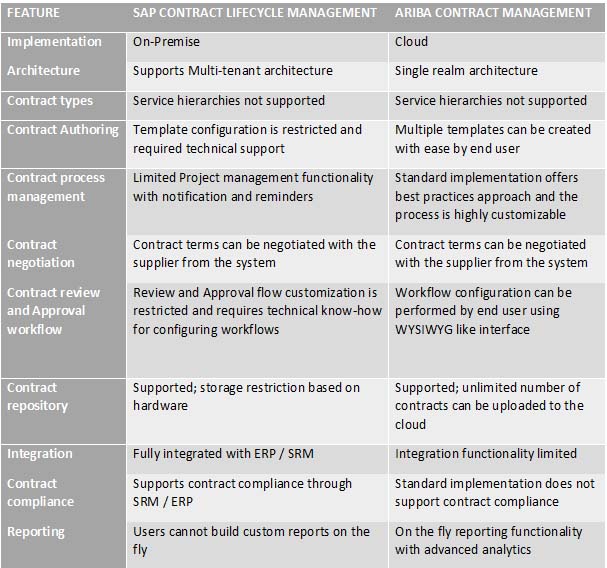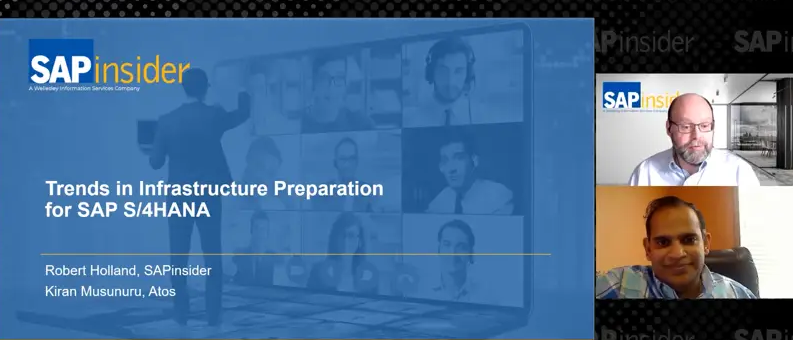Contract Lifecycle Management: Comparing Ariba and SAP
Organizations that look to manage contracts effectively and efficiently have clear-cut agenda. It wants to mitigate financial risk that might arise due to non-compliance of contract and also effectively manage the relationship with vendors, customers and employees who help in creating value. Managing relationships could be a challenging process if there is no visibility and transparency on the terms on which the relationship was built. Even the best framed contracts are of little use if nobody is familiar with them. Several large global conglomerates have realized the importance of creating transparency and accessibility of contracts to all internal stake holders.
Globalization has opened up lot of possibilities for procurement but has also increased the complexity of contracting process due to a variety of legal requirements across the globe.
With increasing competition, even being an industry leader, no longer provides the insulation from market fluctuations. Organizations are caught unprepared with extremely volatile market and price hikes that makes it re-think its contracting strategy and timelines.
Explore related questions
What constitutes a good solution?
Organizations that look to manage contracts effectively and efficiently have clear-cut agenda. It wants to mitigate financial risk that might arise due to non-compliance of contract and also effectively manage the relationship with vendors, customers and employees who help in creating value. Managing relationships could be a challenging process if there is no visibility and transparency on the terms on which the relationship was built. Even the best framed contracts are of little use if nobody is familiar with them. Several large global conglomerates have realized the importance of creating transparency and accessibility of contracts to all internal stake holders.
Globalization has opened up lot of possibilities for procurement but has also increased the complexity of contracting process due to a variety of legal requirements across the globe.
With increasing competition, even being an industry leader, no longer provides the insulation from market fluctuations. Organizations are caught unprepared with extremely volatile market and price hikes that makes it re-think its contracting strategy and timelines.
Explore related questions
What constitutes a good solution?
In such a diverse and complex landscape, having a good contract management solution (People + Process + Technology) serves as a good starting point. With plethora of tools available in the market, it is important to qualify the right solution / vendor that has the right organization fit.
Typically, most solutions claim to offer comprehensive contract management capabilities and features. But, here is a list of basic features that will help to qualify a vendor / solution and will serve as a good starting point.
• Does the solution offer full contracting process and lifecycle – contract drafting, review, negotiation, repository, compliance tracking and administration?
• Does the solution support both buy-side and sell-side contracts?
• Does the solution have a simple and intuitive interface for quicker user / supplier adoption?
• Does the solution have provision for upgrade and is it scalable?
• Does the solution offer seamless integration with the other procurement applications and ERPs in my landscape?
CLM Adoption not just CLM Implementation
The goal of any CLM implementation is to achieve 100% paperless environment, one central repository for all buy-side and sell-side contracts, supplier driven contract collaboration, cycle time tracking and reporting, managing compliance and continuous improvement. However, instead of opting for a big bang implementation which promises all the features and functionality, an incremental approach is required for successful adoption and for the overall success of the project.
For an organization that looks to implement its first CLM tool, the following approach will help in realizing incremental benefits and easier user adoption.
Phase 1:
Enable a basic repository of legacy contracts
CLM tool in place for authoring contracts with standard clause library
Phase 2:
Integrate with Word for collaborating with reviewers and end users
Clause level workflow and approvals are enabled
Enable substitute clauses, alternate clause library
Phase 3:
Enable red-lining and document comparison and store it in the tool
Integrate with Sourcing application for streamlining contract creation
Enable contract compliance by integrating with ERPs / Procurement tools
Business intelligence and advanced analytics are enabled
Phase 4:
All buy-side and sell-side contracts are centralized in one repository
Suppliers driven contract collaboration
Cycle time tracking and continuous reporting
Streamline contract management process with various sourcing and procurement strategies/methods

SAP Contract Lifecycle Management or Ariba Contract Management?
Both SAP Contract Lifecycle Management and Ariba Contract Management provides the functionality and capability to achieve the above incremental benefits. Clients who look for intuitive user interface and collaboration with suppliers on the cloud usually opt for Ariba contract management while the clients who want tighter integration with their ERP systems and SRM system look for SAP CLM.
The future releases that is expected to close the gap between these solutions promises to deliver better integration capabilities with cross-platform / cross-solution enhancements and better UI which would potentially drive down the total cost of ownership. However, it has to be seen at an amplified level as to how these functionalities sit in the overall product strategy of SAP and Ariba.







